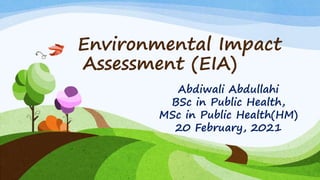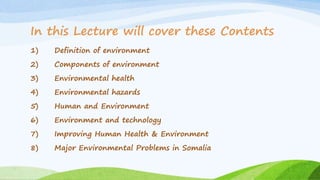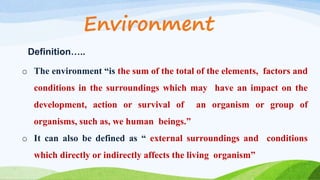1st EIA (introduction to environment).pptx
- 1. Environmental Impact Assessment (EIA) Abdiwali Abdullahi BSc in Public Health, MSc in Public Health(HM) 20 February, 2021
- 3. In this Lecture will cover these Contents 1) Definition of environment 2) Components of environment 3) Environmental health 4) Environmental hazards 5) Human and Environment 6) Environment and technology 7) Improving Human Health & Environment 8) Major Environmental Problems in Somalia
- 4. Definition….. o The environment “is the sum of the total of the elements, factors and conditions in the surroundings which may have an impact on the development, action or survival of an organism or group of organisms, such as, we human beings.” o It can also be defined as “ external surroundings and conditions which directly or indirectly affects the living organism” Environment
- 5. Environment consist of: • BIOTIC FACTORS = living components in an environment. • ABIOTIC FACTORS = non-living components in an environment.
- 6. • Biotic factors and Abiotic factors that surround us and with which we interact. • These biotic and abiotic components are in dynamic state; they constantly affect each other and cannot be isolated from each other.
- 7. Biotic Factors All living organisms Plants Animals Microorganisms Abiotic Factors Water, soil, minerals, gases Temperature, humidity, wind Light, nutrients (C, O, P,N, etc.)
- 8. COMPONENTS OF ENVIRONMENT: • PHYSICAL: air, water, soil, housing, climate, geography, heat, light, noise, debris, radiation, etc. • BIOLOGICAL: man, viruses, microbial agents, insects, rodents, animals and plants, etc. • PSYCHOSOCIAL: cultural values, customs, beliefs, habits, attitudes, morals, religion, education, lifestyles, community life, health services, social and political organization.
- 10. ENVIRONMENTAL HEALTH • Environmental health is the study and management of environmental conditions that affect the health and well-being of humans.
- 11. Definitions of Safe and Risk 11  Safe:  Free from harm or risk  Secure from threat of danger, harm, or loss  Zero risk  Risk:  Possibility of loss or injury, peril  The chance of loss; the degree of probability of such loss.
- 12. Routes of Exposure • Routes of exposure through gaseous, liquid, and solid media 12 Water Air Food Soil Lungs GI Tract Skin GI Tract Skin GI Tract
- 13. Agents and Vectors • Agents • Chemical, biological, and physical • Vectors • Water, air, soil, and food • Routes of entry • Inhalation, ingestion, absorption 13
- 14. Basic Requirements for a Healthy Environment • Clean air • Safe and sufficient water • Safe and adequate food • Safe and peaceful settlements • Stable global environment 14
- 15. Environmental hazards Environmental hazards: A substance, state or event which has the potential to threaten the surrounding natural environment that adversely affects people's health (Pollution and Natural disasters) Environmental hazards may be biological, chemical, physical, psychological, sociological, or site and location hazards.
- 16. These are living organisms or their products that are harmful to humans A. Water-borne diseases are diseases that are transmitted in drinking water 1. Examples are polio virus, hepatitis A virus, Salmonella, Shigella, cholera, amoebic dysentery, Giardia, and Cryptosporidium. 1- Biological hazards
- 17. 3. Our municipal water treatment facilities are usually able to purify water by removing these agents or killing them by disinfecting the water.
- 18. B. Food-borne diseases Food-borne diseases: are diseases transmitted in or on food • 1. Examples of food-borne agents are the bacteria Salmonella, serotype enteritidis, E.coli, as well as other agents. • 2. To protect against food-borne diseases, sanitarians from local health departments routinely inspect food service establishments (restaurants) and retail food outlets (supermarkets) to verify that food is being stored and handled properly.
- 19. C. Vector-borne diseases • Vector-borne diseases; are those transmitted by insects or other arthropods • 1. Examples are St. Louis encephalitis and La Crosse encephalitis transmitted by mosquitoes and plague and murine typhus transmitted by fleas. • 2. Improper environmental management can cause vector- borne disease outbreaks.
- 20. II. Chemical hazards • Chemical hazards: is the result from mismanagement or misuse of chemicals resulting in an unacceptable risk to human health • A. Pesticides are chemicals • that have been manufactured for the purpose of reducing populations of undesirable organisms (pests)
- 21. • 1. Examples of categories of pesticides are herbicides and insecticides. • 2. Most pesticides kill non-target organisms as well as the target, or pest species. • 3. The wise use of pesticides can protect human health and agricultural crops.
- 22. B. Environmental tobacco smoke (ETS) • ETS: is an environmental hazard produced by millions that smoke 1)Diseases associated with ETS include lung cancer and perhaps heart disease. 2)ETS contains 4, 000 substances. 3)The EPA has classified ETS as a Class A carcinogen.
- 23. 1)Smoking has been increasingly restricted from public buildings and from many private work sites. 2)Regulation of smoking seems to be the best approach to controlling this pollutant
- 24. C. Lead • Lead is a naturally occurring element that is used in the manufacturing of many industrial and domestic products • 1. Health problems associated with the over exposure to lead are anemia, birth defects, bone damage, neurological damage, kidney damage, and others. • 2. Exposure is by ingestion and inhalation.
- 25. • 3. Children are particularly at risk from eating peeling lead paint. • 5. Occupational exposure is a major source of lead intake for adults.
- 26. II. Physical hazards • Physical hazards: include airborne particles, humidity, equipment design and radiation • Radon contamination results from over exposure to radon gas. • Radon gas arises naturally from the earth and sometimes occurs at dangerous levels in buildings and homes. • Breathing in radon gas can cause lung cancer. • Homes can be tested for the presence of radon gas.
- 27. III. Psychological hazards • Psychological hazards: are environmental factors that produce psychological changes expressed as stress, depression, hysteria.
- 28. IV. Site and Location Hazards • A. Natural disasters are geographical and meteorological events of such magnitude and proximity to communities that they produce significant damage and injuries. • 1. Examples are cyclones, earthquakes, floods, hurricanes, tornadoes, typhoons, and volcanic eruptions. • 2. The magnitude of devastation of these events can sometimes be great. • 3. Biological, psychological and sociological hazards may increase following a natural disaster.
- 29. Man and Environment relationship • Man is the only living organism capable of modifying environment according to the need. • Man has started hunting animals and cutting trees for his basic needs. • To increase his comforts he started distributing each and every components of environment. • Large scale deforestation, increasing in quantity of CO2 due to burning of forest, grass, crop waste are example of early cause of pollution.
- 30. Impact of Technology on Environment • Positive Impact • Negative Impact – Direct Impact & Indirect Impact Positive Impact Waste treatment plants to reduce the pollution. Electricity generation options Uses of bio-fuels
- 31. Positive Effect • Water treatment plants help us to reuse of dirty water. • Wind turbines help to reduce the needs for coal, electric and other natural resources. • To improve life style & safety of human life, as well as improve the environment of this planet for the future. • The science of sewage treatment is probably the greatest environmental achievement of mankind
- 32. Impact of Technology on Environment (Cont…) • Negative Impacts: Negative effects are further divided into direct and indirect effects. – Direct effect: • Accidents in various industries • Nuclear pollution – Indirect effect • Uses of fossil fuels (include coal, petroleum, natural gas, oil shales, and heavy oils) causes air pollution • Green house effects • Acid rain • Global warming
- 33. Negative Effect a)Direct Effect: It includes accidents , release of pollutants affecting human health, exhaustion of resources and changes in landscapes. b)Indirect Effects: These effects interfere with the vital services supplied to humanity by natural ecological system
- 34. CONT…. • Depletion of ozone layer , which protects the life on earth from damaging UV-B radiations is caused primarily by CFC emissions. • Excessive use of pesticides and fertilizers is decreasing the inherent fertility of soils.
- 35. • The sea level rise due to melting of ice- caps in Antarctic region due to global warming , is frequently disturbing the coastal areas. • Exploitation of resources leading to exhaustion. • Testing of atomic bombs may cause volcanoes and earth quakes
- 36. Improving Human Health & Environment: (3 Models) 36
- 37. Cont.. 37
- 38. Cont.. 38
- 39. Problem-Solving Paradigm: Six Steps 1. Define the problem 2. Measure its magnitude 3. Understand key determinants 4. Develop intervention/prevention strategies 5. Set policy/priorities 6. Implement and evaluate 39 Risk assessment Risk management
- 40. Risk assessment • The determination of the probability that an adverse effect will result from a defined exposure • Hazard identification • Exposure assessment • Dose-response assessment • Risk characterization • Pure “science” activities 40
- 41. Risk management • The process of weighing policy alternatives and selecting the most appropriate regulatory actions based on the results of risk assessment and social, economic, and political concerns. 41
- 42. Environmental global issues • Overpopulation • Intensive farming • Land degradation • Use of toxins • Waste management • Pollution: water, air, soil. • Climate change • Ozone depletion • Resource depletion 42
- 43. Major Environmental Problems in Somalia • Deforestation • Droughts • Floods • Pollution and contamination of water • The toxic wastes that are illegally dumped in Somali seawater and the land. 43
- 44. Any Question ?












































